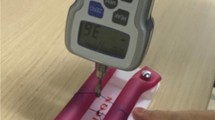Abstract
Background
Knotting sutures by hand is still important in daily surgical routine, especially laparotomy closure. The expectation is that hand suturing relies on the experience and subjective estimation of the surgeon. The aim of this study was to investigate whether hand suturing tension is reproducible and if surgical experience influences reproducibility.
Methods
At the annual Congress of the German Association of Surgery, 118 surgeons performed repetitive sutures on a standardized and certified measuring device simulating the final knot of a fascial closure. Each surgeon was asked to perform five identical single knots in a row using the suture tension that each considered ideal. Tension during knotting was measured in Newtons. The surgeons were divided into five subgroups based on surgical experience: group 1, <1 year; group 2, 2–5 years; group 3, 6–10 years; group 4, 11–20 years; and group 5, >30 years.
Results
The tension measured at the end of knotting ranged from 0.19 to 10 N. The mean suture tension at endpoint was 3.88 N for group 1 and slightly higher in the other groups, but not significantly different. The overall mean suture tension was 5.43 N and did not correlate with surgical experience. Suture tension was not reproducible.
Conclusion
Sequential suture tension varied, even among experienced surgeons. The ideal tissue-dependent suture tension has not been defined. Measured values appear to be intuitive, relying on individual feeling rather than the level of experience.


Similar content being viewed by others
References
Israelsson LA, Jonsson T (1993) Suture length to wound length ratio and healing of midline laparotomy incisions. Br J Surg 80(10):1284–1286
Myers MB, Cherry G (1970) Functional and angiographic vasculature in healing wounds. Am Surg 36(12):750–756
Bartlett LC (1985) Pressure necrosis is the primary cause of wound dehiscence. Can J Surg 28(1):27–30
Fielding LP, Stewart-Brown S, Blesovsky L, Kearney G (1980) Anastomotic integrity after operations for large-bowel cancer: a multicentre study. Br Med J 281(6237):411–414
Sugerman HJ, Kellum JM Jr, Reines HD, DeMaria EJ, Newsome HH, Lowry JW (1996) Greater risk of incisional hernia with morbidly obese than steroid-dependent patients and low recurrence with prefascial polypropylene mesh. Am J Surg 171(1):80–84. doi:10.1016/S0002-9610(99)80078-6
Fischer L, Bruckner T, Muller-Stich BP, Hoer J, Knaebel HP, Buchler MW, Seiler CM (2010) Variability of surgical knot tying techniques: do we need to standardize? Langenbeck’s Arch Surg [Deutsche Gesellschaft fur Chirurgie] 395(4):445–450. doi:10.1007/s00423-009-0575-8
Stumpf M, Klinge U, Mertens PR (2004) Anastomotic leakage in the gastrointestinal tract-repair and prognosis. Der Chir Z Geb Oper Med 75(11):1056–1062. doi:10.1007/s00104-004-0956-z
Jansen PL, Mertens Pr P, Klinge U, Schumpelick V (2004) The biology of hernia formation. Surgery 136(1):1–4. doi:10.1016/j.surg.2004.01.004
Zheng H, Si Z, Kasperk R, Bhardwaj RS, Schumpelick V, Klinge U, Klosterhalfen B (2002) Recurrent inguinal hernia: disease of the collagen matrix? World J Surg 26(4):401–408. doi:10.1007/s00268-001-0239-5
Junge K, Klinge U, Rosch R, Mertens PR, Kirch J, Klosterhalfen B, Lynen P, Schumpelick V (2004) Decreased collagen type I/III ratio in patients with recurring hernia after implantation of alloplastic prostheses. Langenbeck’s Arch Surg [Deutsche Gesellschaft fur Chirurgie] 389(1):17–22. doi:10.1007/s00423-003-0429-8
Bellon JM, Bajo A, Ga-Honduvilla N, Gimeno MJ, Pascual G, Guerrero A, Bujan J (2001) Fibroblasts from the transversalis fascia of young patients with direct inguinal hernias show constitutive MMP-2 overexpression. Ann Surg 233(2):287–291
Hoer J, Wetter O, Peschke C, Schumpelick V, Weck M (2001) Einsatz miniaturisierter Sensoren zur Kontrolle von Naht- und Fadenspannung in der Chirurgie. In: Neue Technologien für die Medizin.. Neue Technologien für die Medizin, Forschung, Praxis, Innovation 3 Symposium 10/11 Mai 2001. Aachen, Shaker
Klink CD, Binnebosel M, Alizai HP, Lambertz A, von Trotha KT, Junker E, Disselhorst-Klug C, Neumann UP, Klinge U (2011) Tension of knotted surgical sutures shows tissue specific rapid loss in a rodent model. BMC Surg 11:36. doi:10.1186/1471-2482-11-36
Tera H, Aberg C (1976) Tissue strength of structures involved in musculo-aponeurotic layer sutures in laparotomy incisions. Acta Chir Scand 142(5):349–355
Stone IK, von Fraunhofer JA, Masterson BJ (1986) The biomechanical effects of tight suture closure upon fascia. Surg Gynecol Obstet 163(5):448–452
Schachtrupp A, Wetter O, Hoer J (2015) An implantable sensor device measuring suture tension dynamics: results of developmental and experimental work. Hernia: the journal of hernias and abdominal wall surgery. doi:10.1007/s10029-015-1433-y
Acknowledgement
This work was supported by Ethicon, Johnson & Johnson, Norderstedt, Germany.
Authors’ contributions
KTvT, JG and MB contributed to the study conception and design. KTvT, NB, AL and CDK contributed to the acquisition of data. KTvT, JG, NB, AL, CDK, UPN, MJ and MB contributed to the analysis and interpretation of data. KTvT, JG, NB, AL, CDK, UPN, MJ and MB contributed to the drafting of manuscript. KTvT, JG, NB, AL, CDK, UPN, MJ and MB contributed to the critical revision of manuscript.
Author information
Authors and Affiliations
Corresponding author
Ethics declarations
Conflict of interest
All authors declare that they have no conflict of interest.
Funding
The measuring device as well as the sutures were provided by Ethicon, Johnson & Johnson, Norderstedt, Germany, no further funding was received.
Ethical approval
All procedures performed in studies involving human participants were in accordance with the ethical standards of the institutional and/or national research committee and with the 1964 Helsinki declaration and its later amendments or comparable ethical standards.
Human and animal rights
This article does not contain any studies with animals performed by any of the authors.
Informed consent
Informed consent was obtained from all individual participants included in the study.
Rights and permissions
About this article
Cite this article
von Trotha, KT., Grommes, J., Butz, N. et al. Surgical sutures: coincidence or experience?. Hernia 21, 505–508 (2017). https://doi.org/10.1007/s10029-017-1597-8
Received:
Accepted:
Published:
Issue Date:
DOI: https://doi.org/10.1007/s10029-017-1597-8




